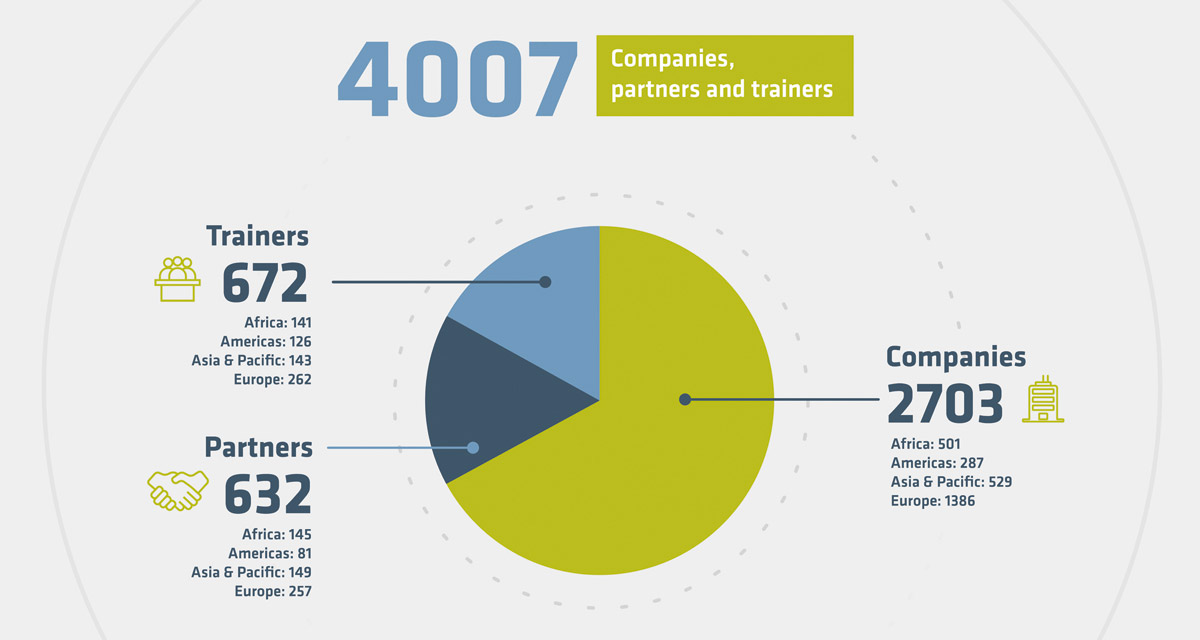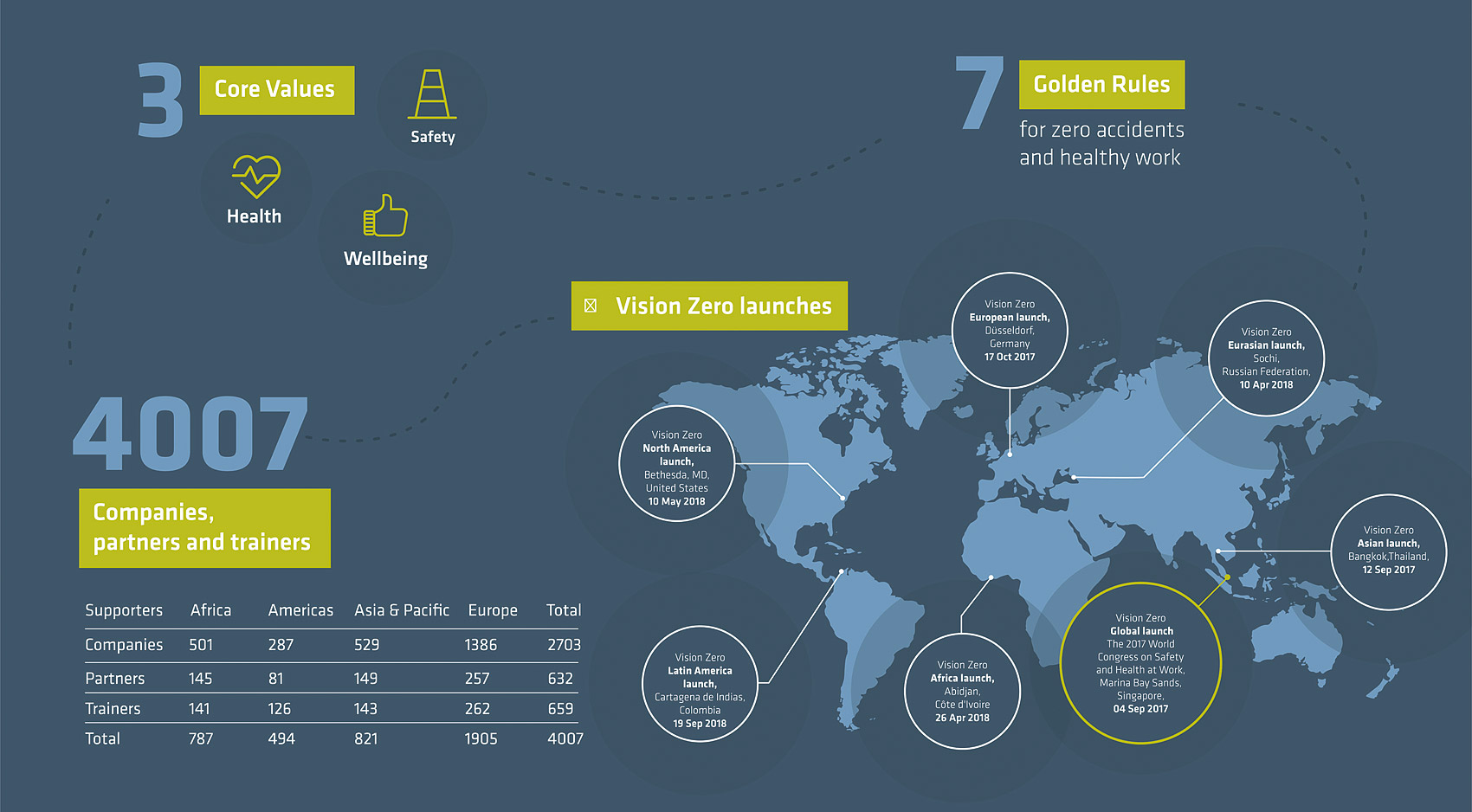Four years of VISION ZERO at BG RCI – one year of VISION ZERO in an international context. This was reason enough to ask Helmut Ehnes, the Head of Prevention at the German Social Accident Insurance Institution for the Raw materials and Chemical Industry (BG RCI) in Langenhagen/Germany, in autumn 2018 to draw up a first interim report in a personal interview with the editors of the magazine Steine und Erden. The interview was first published in special edition no. 11/2018 of “Steine und Erden” magazine. Prior to that, however, a brief overview of the status of the VISION ZERO campaign at international level was given.
VISION ZERO now has 4,007 supporters from 141 countries (Figures 1, 2). Since its launch on 4th September 2017, at the XXI World Congress on Safety and Health at Work, there is a tremendous growth and success of the campaign.
Europe is the biggest and fastest growing VISION ZERO region, with 1,905 partners, companies and trainers signed up. There are VISION ZERO supporters from more than 40 European countries, and Russia has the highest number of supporters of all countries.
There has been high activity in Africa. After the African launch in Côte d’Ivoire in April 2018, there were launches in Nigeria, Ghana and Zambia. The Côte d’Ivoire and Zambia are particularly active with 446 supporters combined. Côte d’Ivoire has particularly high interest from trainers.
In recent months, there has also been an increase interest from Latin American countries. The Latin American launch took place in September 2018, and since December there have been 30 to 40 newcomers to the VISIO ZERO campaign every month.
VISION ZERO started in Asia, with the global launch in Singapore followed by the regional launch in Thailand. Asia and the Pacific is today the second biggest VISION ZERO region with 821 partners, companies and trainers.
The next VISION ZERO launch was for Central Africa, it took place in Gabon from 11th to 12th April 2019, and the first VISION ZERO summit will take place in Finland in October 2019.

Fig. 3. Helmut Ehnes, Head of Prevention at BG RCI. // Bild 3. Helmut Ehnes, Leiter der Prävention bei der BG RCI. Photo/Foto: BG RCI
Interview with Helmut Ehnes.
Steine und Erden: Mr Ehnes, what were the origins of VISION ZERO?
Helmut Ehnes (Figure 3): We’re doing this because we continue to lament the current situation that someone leaves for work in the morning and never returns to their family. We’re doing this because among our insured persons, one in twenty will have an accident either at work or on the way to work each year. And we’re doing this because all of this doesn’t just cause great suffering for those involved – it also costs a lot of money. In the case of BG RCI, we have to raise around 1 bn € each year to cover the costs incurred by accidents at work and occupational illnesses. The autonomous administration at BG RCI discussed these issues in 2013 and 2014 and established VISION ZERO, a prevention strategy for BG RCI, in 2014. This makes it clear that we are not prepared to put up with the situation as described above – we are convinced that every workplace accident and every occupational illness is preventable, provided that the right preventative measures are implemented at the right time. This is our fundamental belief, to which there really is no other alternative, when the situation is considered in more detail. After all, who wants to openly acknowledge that businesses accept and take into account fatal accidents at work, injuries and occupational damage to health when they are calculating their budgets?
Steine und Erden: Is VISION ZERO limited to Germany and the BG RCI?
Ehnes: No, not any more. The idea we brought into being at the BG RCI has attracted global attention since its conception, thanks to the International Social Security Association (ISSA). This culminated in the international launch of the global VISION ZERO strategy at the World Congress on Safety and Health at Work 2017 in Singapore. In front of over 4,000 enthusiastic listeners, the international campaign was launched by the ISSA and the seven success factors developed by BG RCI were projected on the big screen as the 7 Golden Rules of VISION ZERO. Since then, the BG RCI VISION ZERO guidelines have been translated into ten languages, almost 3,000 well-known businesses and organisations have committed to the initiative and more are joining by the day. The concept of VISION ZERO has been met with great enthusiasm on every continent – the basic idea is so accessible and credible, and VISION ZERO really speaks to people emotionally. Additionally, VISION ZERO is compatible with national laws and regulations. Alongside the guidelines and the VISION ZERO website www.visionzero.global, a VISION ZERO training curriculum has been drawn up and provided to the partners. The ISSA launched the first training course for disseminators in January 2019 and it has been met with great interest.
Steine und Erden: Sometimes people say that VISION ZERO is just another management system. How would you respond to this?
Ehnes: This counterargument seems credible at first glance, and I’ve already come across it. However, it’s easy to disprove. Management systems for occupational safety and health are based on traditional risk management and used to fulfil legal requirements. In contrast, VISION ZERO requires management teams to be actively involved and aims to use its clear stance in order to attain standards that go above and beyond legal requirements. It brings the issue of occupational safety closer to the heart and ensures that every member of the operation is part of the process. The aim of VISION ZERO is to change our culture, to establish a culture of prevention in which safety and health are seen as intrinsic business values. While classic management systems place great significance on regulations, specifications and documentation, so that only experts and managers feel responsible, VISION ZERO aims to take everything and everyone into account, encouraging the entire workforce to put forward their own ideas and suggest solutions. Incidents are no longer seen as mistakes, but as opportunities to learn. VISION ZERO requires an entirely different management and communication culture based on mutual trust.
Steine und Erden: Have there been any initial results? What impact has VISION ZERO had?
Ehnes: Naturally, it’s a difficult task to determine how successful or unsuccessful preventative measures have been. If you were to ask me how VISION ZERO has had an impact on the BG RCI member companies, the first thing I’d think of is the numerous discussions we have had, as well as the feedback and positive support that all groups have given to VISION ZERO. Most recently, this has once again been demonstrated at the VISION ZERO Forum protecT event in Bamberg (Figure 4) only a few days ago – with over 300 participants, this event was sold out again.
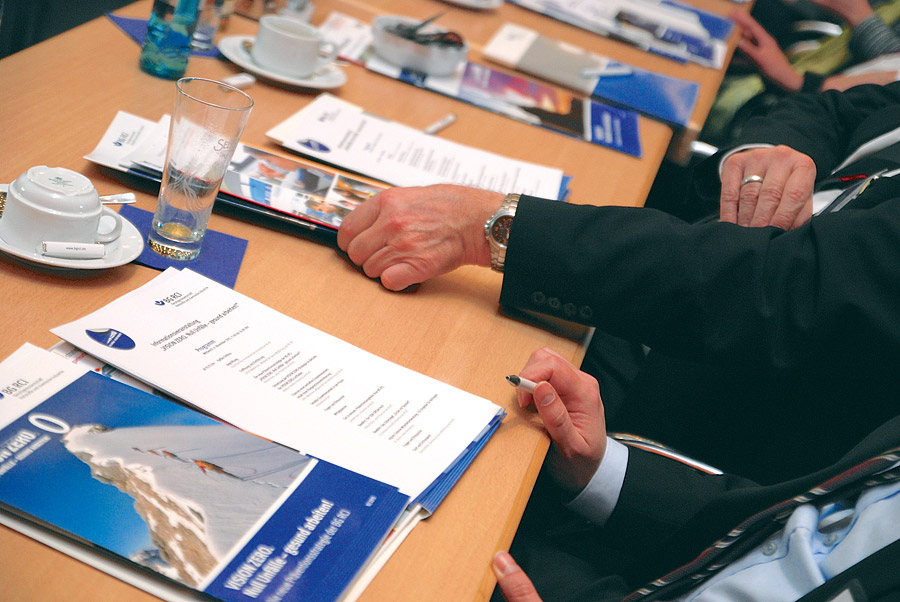
Fig. 4. Forum protecT, organised by BG RCI – an extremely popular biannual event for business owners that focuses on a range of prevention issues – has been integrated into the VISION ZERO communication portfolio. // Bild 4. Das Forum protecT der BG RCI – eine äußerst beliebte, alljährliche Doppelveranstaltung für Unternehmer zu verschiedenen Präventionsthemen – wurde in das VISION ZERO-Kommunikationsportfolio integriert. Photo/Foto: BG RCI
There, we received positive feedback from representatives of the industrial chemistry sector and from an entrepreneur at a medium-sized company who described the VISION ZERO guidelines as a “real blessing”. Another thing that comes to mind is the great support that we have seen for the seven success factors and the corresponding guidelines. Not to mention the feedback from the customer surveys that we introduced as part of our prevention strategy. But of course, none of that is solid, fact-based evidence. In the end, we’re going to have to wait and see how the number of workplace accidents and occupational illnesses develops. For this reason, we have also developed seven concrete aims for the first ten years of the initiative that will allow us to monitor these indicators. What is certain is that four years is too short a time period to draw any final conclusions – we have initially concentrated our efforts on analysing the numbers and developing suitable prevention tools and messages. Of course, we are already observing the progress of the most significant key figures. My initial conclusion is that there is reason for hope. For example, we are well on target when it comes to the new accident pensions – our aim in this respect is to reduce the number by at least half over the next ten years (Figure 5). Of course, we have corresponding evaluations for all relevant key figures.
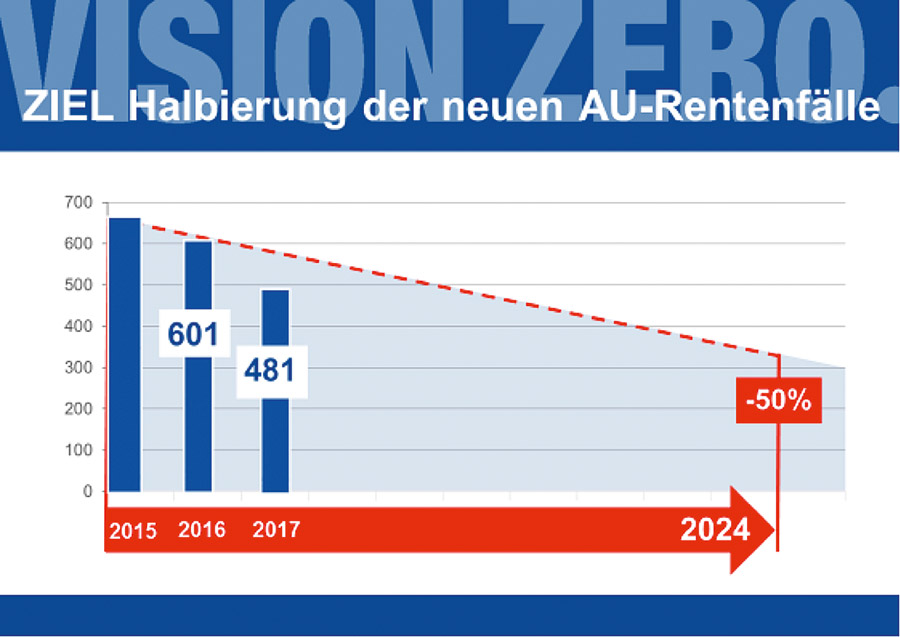
Fig. 5. Since 2015, the number of pension cases has been declining significantly. If this continues, BG RCI will have achieved its aim of halving this figure in 2024. // Bild 5. Seit 2015 ist ein deutlicher Abwärtstrend in den Rentenfällen zu verzeichnen. Sollte er anhalten, hätte die BG RCI im Jahr 2024 ihr Ziel, die Halbierung, erreicht. Source/Quelle: BG RCI
Steine und Erden: When you are asked what the core of the VISION ZERO strategy is, what is your answer?
Ehnes: On this topic, I want to say that we have made good progress in developing a new, compact type of tool that can be used to implement the seven success factors. The VISION ZERO guideline has been well received as a key starting tool, can be used in a wide variety of ways and has been implemented all over the world. The seven consolidation guidelines follow the same format and received excellent feedback in their initial practical test at Forum protecT.
Steine und Erden: Yes, that was the verdict from a lot of the participants who tested the new consolidation guidelines…
Ehnes: And there’s even more. Our lifesavers have been adopted exactly as they are by a number of companies and integrated into their own intranet – their clear, concise messages are proving to be popular. Tried-and-tested prevention products such as incentive awards, the young workers competition and the seal of approval, have become a key part of the VISION ZERO strategy and are well integrated. Furthermore, the new VISION ZERO seminars that we offer for managers have already generated a lot of interest. All in all, VISION ZERO has helped to provide a clear structure for our varied prevention products; we are now in a great position when it comes to our content.
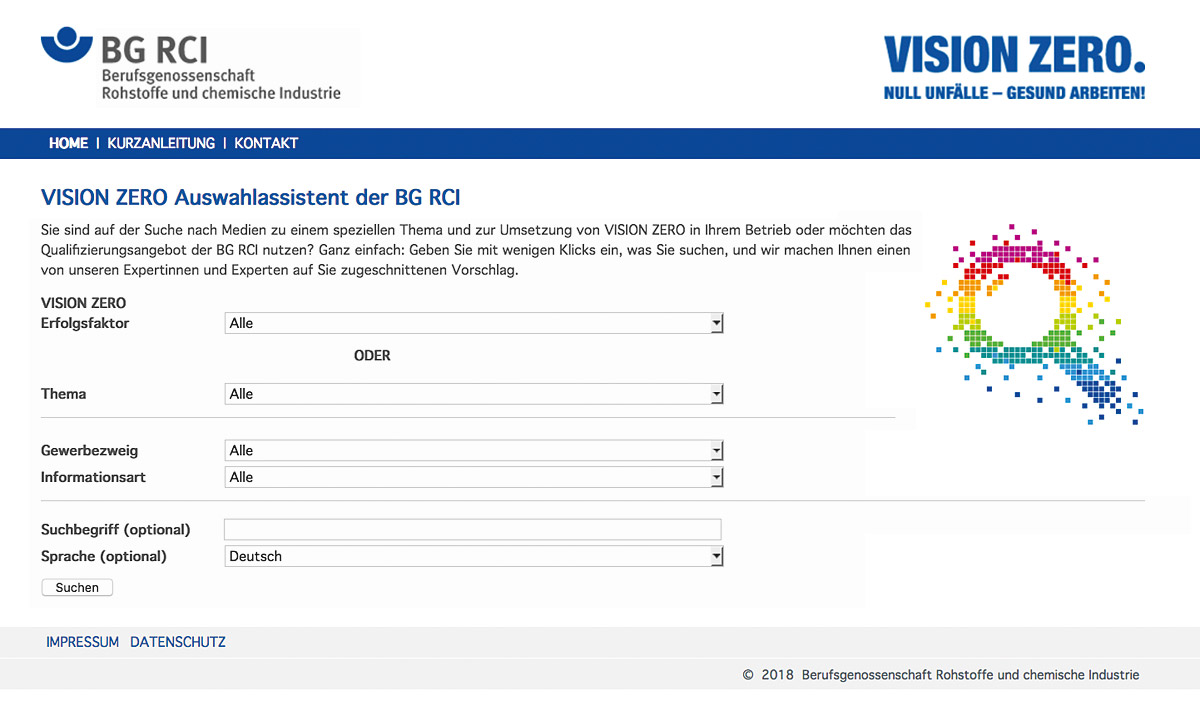
Fig. 6. The selection assistant can be found at https://awa.bgrci.de/ and makes it easier to search for suitable VISION ZERO media and practical aids. // Bild 6. Der Auswahlassistent, zu finden auf der Webpage https://awa.bgrci.de/, vereinfacht die Suche nach passenden Medien und Praxishilfen der VISION ZERO. Source/Quelle: BG RCI
Steine und Erden: And how do you ensure that this is all being used and implemented at the companies?

Fig. 7. The “Der Rote Faden” brochure, available in German from the BG RCI online media shop, explains what media to use and when is best to use it in order to implement VISION ZERO in a business. // Bild 7. „Der Rote Faden“, erhältlich im Online-Medienshop der BG RCI, erläutert, wann idealerweise welche Medien eingesetzt werden können, um die VISION ZERO im Unternehmen zu implementieren. Source/Quelle: BG RCI
Ehnes: A good question – after all, even the best products are useless if nobody knows about them. It’s for this exact reason that we have also intensified our efforts regarding VISION ZERO communication and knowledge transfer over the past year. Our VISION ZERO selection assistant (AWA) is new – it helps users to find the right consolidation product in no time. AWA is almost an intelligent search engine, designed to help people achieve their goals faster (Figure 6).
Our VISION ZERO website www.null-ist-das-ziel.de is also new. It provides all available VISION ZERO products in a single location. Since 1st November 2018, the seven consolidation guidelines have also been available online on this website. The VISION ZERO newsletter and the “Der Rote Faden” brochure are also worth mentioning (Figure 7). Finally, I have to mention the VISION ZERO cooperation agreements that are also aiding the transfer. Agreements of this kind have already been established with 20 associations. At an initial meeting with the associations’ representatives, they were impressed with the compact range that was on offer at the time and pledged to focus more on transfer to companies via their channels. All in all, I’m convinced that we have also made good progress when it comes to transfer and communication.
Steine und Erden: Can you describe any particularly striking example of VISION ZERO being adopted by companies?
Ehnes: An example that immediately comes to mind is Dräger in Lübeck – they aren’t a member of BG RCI, but they are an important safety technology supplier for many of our sectors. People at Dräger recognised the potential of VISION ZERO. You can see this, for instance, in Dräger’s sustainability report, which contains statements regarding VISION ZERO and even the VISION ZERO logo. A real example for others to follow. A clear statement from Stefan Dräger determined their approach and in the end, Dräger even produced their own VISION ZERO videos that get to the heart of the joint relationship between Dräger and their customers.
Steine und Erden: What happens now? What are the next steps and what do you think of the situation so far?
Ehnes: In my opinion, we mustn’t simply make desperate efforts to get more and more new products on the market just for the sake of it – after all, as I’ve explained, I think our position there is solid. I’m pleased to announce two current plans, though. We are aiming to develop an app under the working name “Accident communication” that will enable us to make information about significant accident events with prevention potential available quickly and in a targeted manner. The aim of this is to inform relevant companies about events of this nature and to prevent the same accident occurring again at a different location. Additionally, as part of an international joint project, we want to develop suitable indicators that can be used to record, assess and compare the course of VISION ZERO and the corresponding prevention culture. It’s an exciting project that lots of businesses have expressed interest in, as they too are looking for new control indicators. Businesses that have recorded more than just retrospective accident rates in their internal reports on this subject are invited to make their observations available to us for preparatory purposes.
